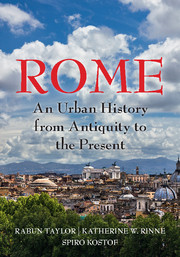Book contents
- Frontmatter
- Dedication
- Epigraph
- Contents
- List of Illustrations
- Acknowledgments
- Map
- INTRODUCTION
- 1 A BEND IN THE RIVER
- 2 A STORYBOOK BEGINNING
- 3 IDEOLOGICAL CROSSFIRE
- 4 BIG MEN ON THE CAMPUS
- 5 RES PUBLICA RESTITUTA
- 6 MEMORIALS IN MOTION: SPECTACLE IN THE CITY
- 7 THE CONCRETE STYLE
- 8 REMAKING ROME'S PUBLIC CORE: I
- 9 REMAKING ROME'S PUBLIC CORE: II
- 10 CRISIS AND CONTINUITY
- 11 RUS IN URBE: A GARDEN CITY
- 12 ADMINISTRATION, INFRASTRUCTURE, AND DISPOSAL OF THE DEAD
- 13 MAPPING, ZONING, AND SEQUESTRATION
- 14 TETRARCHIC AND CONSTANTINIAN ROME
- 15 TROPHIES AND TITULI: CHRISTIAN INFRASTRUCTURE BEFORE CONSTANTINE
- 16 WALLS MAKE CHRISTIANS: FROM FOURTH TO FIFTH CENTURY
- 17 A TALE OF TWO ROMES
- 18 THE ROME OF GOTHS AND BYZANTINES
- 19 CHRISTIAN FOUNDATIONS
- 20 FROM DOMUS LATERANI TO ROMANUM PALATIUM
- 21 THE LEONINE CITY: ST. PETER'S AND THE BORGO
- 22 VIA PAPALIS, THE CHRISTIAN DECUMANUS
- 23 THE URBAN THEATERS OF IMPERIUM AND SPQR
- 24 HOUSING DAILY LIFE
- 25 CHAOS IN THE FORTIFIED CITY
- 26 THE TIBER RIVER
- 27 HUMANIST ROME, ABSOLUTIST ROME (1420–1527)
- 28 PLANNING COUNTER REFORMATION ROME
- 29 PROCESSIONS AND POPULATIONS
- 30 MAGNIFICENT PALACES AND RHETORICAL CHURCHES
- 31 NEOCLASSICAL ROME
- 32 PICTURING ROME
- 33 REVOLUTION AND RISORGIMENTO
- 34 ITALIAN NATIONALISM AND ROMANITÀ
- 35 A CITY TURNED INSIDE OUT
- Glossary of Persons, Places, and Terms
- Works Cited
- Index
31 - NEOCLASSICAL ROME
Published online by Cambridge University Press: 05 July 2016
- Frontmatter
- Dedication
- Epigraph
- Contents
- List of Illustrations
- Acknowledgments
- Map
- INTRODUCTION
- 1 A BEND IN THE RIVER
- 2 A STORYBOOK BEGINNING
- 3 IDEOLOGICAL CROSSFIRE
- 4 BIG MEN ON THE CAMPUS
- 5 RES PUBLICA RESTITUTA
- 6 MEMORIALS IN MOTION: SPECTACLE IN THE CITY
- 7 THE CONCRETE STYLE
- 8 REMAKING ROME'S PUBLIC CORE: I
- 9 REMAKING ROME'S PUBLIC CORE: II
- 10 CRISIS AND CONTINUITY
- 11 RUS IN URBE: A GARDEN CITY
- 12 ADMINISTRATION, INFRASTRUCTURE, AND DISPOSAL OF THE DEAD
- 13 MAPPING, ZONING, AND SEQUESTRATION
- 14 TETRARCHIC AND CONSTANTINIAN ROME
- 15 TROPHIES AND TITULI: CHRISTIAN INFRASTRUCTURE BEFORE CONSTANTINE
- 16 WALLS MAKE CHRISTIANS: FROM FOURTH TO FIFTH CENTURY
- 17 A TALE OF TWO ROMES
- 18 THE ROME OF GOTHS AND BYZANTINES
- 19 CHRISTIAN FOUNDATIONS
- 20 FROM DOMUS LATERANI TO ROMANUM PALATIUM
- 21 THE LEONINE CITY: ST. PETER'S AND THE BORGO
- 22 VIA PAPALIS, THE CHRISTIAN DECUMANUS
- 23 THE URBAN THEATERS OF IMPERIUM AND SPQR
- 24 HOUSING DAILY LIFE
- 25 CHAOS IN THE FORTIFIED CITY
- 26 THE TIBER RIVER
- 27 HUMANIST ROME, ABSOLUTIST ROME (1420–1527)
- 28 PLANNING COUNTER REFORMATION ROME
- 29 PROCESSIONS AND POPULATIONS
- 30 MAGNIFICENT PALACES AND RHETORICAL CHURCHES
- 31 NEOCLASSICAL ROME
- 32 PICTURING ROME
- 33 REVOLUTION AND RISORGIMENTO
- 34 ITALIAN NATIONALISM AND ROMANITÀ
- 35 A CITY TURNED INSIDE OUT
- Glossary of Persons, Places, and Terms
- Works Cited
- Index
Summary
ROME'S PERPETUAL BUILDING BOOM OBSCURED THE HARSH REALITY THAT the Church's political, economic, cultural, and theological influence had waned. While the rest of Europe celebrated the dawning Age of Enlightenment by embracing scientific inquiry, instrument making, and experimentation, the pope and his curial administration stubbornly resisted any intellectual challenges. The paranoid Roman Inquisition, seeing heresy everywhere, answered perceived subversion with either imprisonment or death.
When not absorbed in doctrinal matters, popes also considered urban issues, but for the most part, their focus now shifted to completing construction projects already in progress or initiating projects that addressed severe urban or social problems. Innocent XII Pignatelli (1691–1700), for example, formalized the Ripa Grande on the Trastevere riverfront. His monumental Ospizio Apostolico di San Michele, directly across the Tiber from the Aventine, encompassed a public hospital, orphanage, and reformatory. Though it answered an urgent social need, its immensity overwhelmed lower Trastevere and reinforced the district's associations with the underclass and outcasts for the next 300 years. Innocent's successors repaired consular roads to speed imports into Rome; enlarged Rome's granaries, now located in the ruins of the Baths of Diocletian; and, as we saw in Chapter 28, facilitated urban traffic and commerce at the Ripetta and the Spanish Steps.
This concern with social projects had its exceptions, most notably Clement XII Corsini's (1730–1740) decision to raise a new Trevi Fountain over Bernini's unfinished scheme, which still languished as a glorified washbasin and animal trough (see Fig. 173). In 1732 he launched a design competition, won by the architect Nicola Salvi. Construction plodded on over two more pontificates and 30 years, but when it was inaugurated in 1762 the Trevi quickly became the talk of Europe (Fig. 191). Now a properly dignified terminus for the venerable Acqua Vergine, it was the eighteenth century's answer to Paul V's colossal fountain on the Janiculum. Its ornate 50-meter span occupies almost the entire width of a constricted piazza where three streets converge. The Trevi, surely the world's favorite fountain, emblematizes Rome as certainly as the city's most famous building, the crosstown Colosseum. Like Hadrian's Venus, annexed dorsally to her sterner counterpart Roma, it represents Rome's gentler and more nourishing aspect.
- Type
- Chapter
- Information
- RomeAn Urban History from Antiquity to the Present, pp. 292 - 302Publisher: Cambridge University PressPrint publication year: 2016



